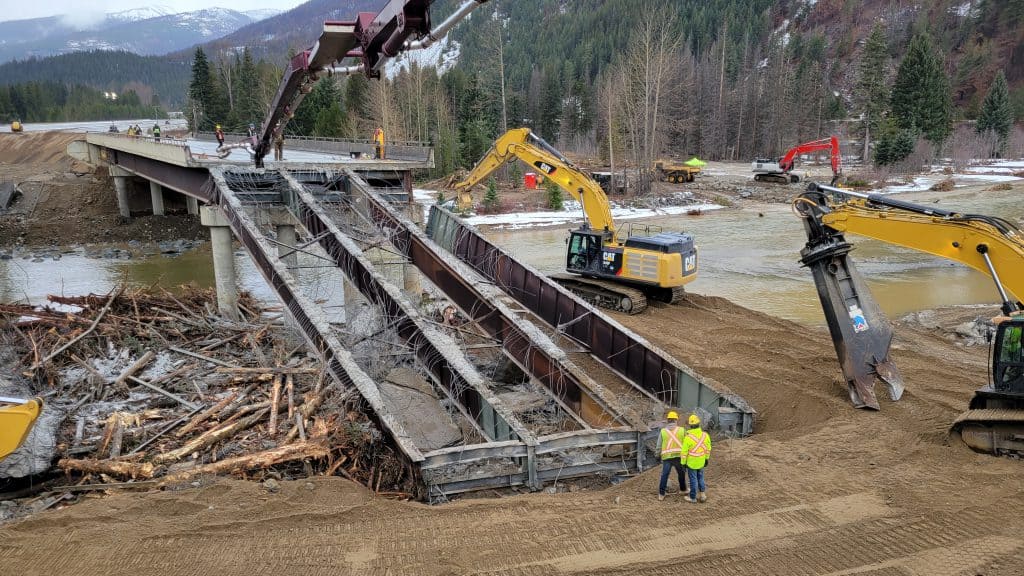Imagine: It’s the month before Christmas and people are busy completing year-end tasks in preparation for the holidays. Suddenly, a weather pattern delivering record-breaking amounts of precipitation — a month’s worth of rain in three days — causes widespread flooding, landslides, loss of power, internet outages and road closures that debilitate an entire region.
Sounds like the plot of a movie, right? Sadly, this was reality for many people that call British Columbia home. The province experienced unprecedented rainfall Nov. 13-15, 2021, that crippled infrastructure in the region. Mudslides and span breaks on critical bridges brought traffic to a halt. A town hit particularly hard was the District of Hope, a small municipality that was completely cut off from the Lower Mainland and the rest of British Columbia.
People were left stranded on highways and commerce was crippled. Resources were extremely limited and urgent response was needed.
In the midst of dire circumstances, Peter Kiewit Sons ULC was ready to step in to meet the significant challenge. Kiewit had 200 people working on a project in the area at the time of the flooding, and they became emergency response personnel almost overnight.
Immediate response
After ensuring the safety of employees, Kiewit immediately took action to meet pressing needs in the community. Kiewit personnel helped staff the refugee center, providing shelter to those in need, helicoptering in supplies, and managing medical care for community members by establishing phoneline access to medical professionals. Kiewit played a critical role in the immediate efforts to ensure the town’s residents were safe until road access was restored.
Simultaneously, Kiewit workers got to work. They helped clear mudslides and worked to restore road access, working from both ends of the highway. This included significant coordination from Kiewit engineering and construction teams, all at a rapid pace. The goal was to restore traffic flow on the Coquihalla Highway, the main commercial transportation route in the region, by the Christmas holiday.
In a lot of ways, it was very fortunate that Kiewit had such a large existing presence in Hope.
“We had people, equipment and fuel on site that were right there, and our people were qualified to start digging through all of this landslide material,” said Kiewit Project Director Chris Dandurand. “Had we not been there, the community would have had to rely on external resources, which were limited.”
Assessing the damage
Kiewit Construction Manager Danny Harding described his first reaction upon arriving in the town of Merritt, which was the central location for response efforts in the north.
“Pulling in felt like a war zone. There was a base camp set up with helicopters flying resources south. There were four or five helicopters in the air at all times,” he said. “The industry response was an all-hands-on-deck approach, and there was a lot of activity going on at all times.”
One of the first priorities was assessing the damage caused by the storm. In addition to the closure of five main highways in the region — Highways 1, 3, 5 (also known as the Coquihalla Highway), 7 and 99 — four river crossings along Highway 5 were debilitated and rail lines were demolished. Highway 5 had over 25 impacted areas, including parts where the road completely washed out.
With mudslides still being cleared, Kiewit engineering teams were engaged to start working on solutions for the significant infrastructure damage. Getting additional information was key. Kiewit personnel worked to obtain as many photos as possible to assess the damage, conducting drone photogrammetry and drone surveys to provide topographic data.
Forging solutions
Under the leadership of the British Columbia Ministry of Transportation and Infrastructure, Kiewit worked with multiple highway maintenance and First Nations contractors, as well as other stakeholders, to make repairs. Within two weeks, Kiewit mobilized 290 workers, 110 pieces of heavy equipment and 34 designers.
Kiewit played a key role by providing both construction and engineering support. The repair effort resembled a design-build model. “Construction was progressing literally at the same time as our designs,” said Kiewit Engineering Operations Director Jorge Antunes. “It was difficult to stay ahead of construction. We would say it felt like a build-design project, not a design-build project.”
There was also great urgency to reestablish traffic. “The quick mobilization was the number one challenge of the project,” said Kiewit Area Manager Pat Wilson. “At Kiewit, we have a very detailed and established process for starting up a job, which typically takes months. Coming in and seeing the damage, we realized we were going to need to start things up in 12 hours.”
Some of the most significant damage was at the bridges on the Coquihalla Highway. The Juliet, Bottletop, Carolin and Jessica bridges were hit particularly hard. All were in various states of disrepair. On the Jessica Bridge, there were two approach spans down that were not salvageable. Kiewit engineering and construction teams found ways to demolish those approach parts and build a Geo-synthetically Reinforced Soil (GRS) retaining wall along with a custom pre-cast concrete jump span as a temporary fix to restore traffic flow.
When asked about the keys to success, Antunes said, “The integration of our design and construction teams made this possible. We had phone calls every day, sometimes hourly. It was this kind of open, transparent discussion that allowed us to make informed decisions that were right for the project.”
Whether it was a geotechnical concern for ground stability, a materials question on what could be used to reinforce embankments, or a structural fix needed to secure a bridge, Kiewit’s engineering and construction teams were often working with sketches in notebooks or measurements taken by hand, while access to power and technology was still scarce.
After five weeks of around the clock work, a significant milestone was reached when the Coquihalla Highway reopened to commercial traffic and inter-city buses, before Christmas, and thanks in large part to the Kiewit teams in Western Canada and across North America.
Peter Kiewit Sons ULC Senior Vice President Ryan Tones said, “It was incredible to see everyone working together toward one common goal. Kiewit was uniquely qualified to complete this work as quickly as we did because of our fully integrated design and construction approach, which is unmatched in the industry. We operate as one unified team to solve problems and that was what allowed us to get Highway 5 opened so quickly.”
Coming together
The impact of the repair efforts and the speed at which they were completed cannot be understated. British Columbia Transportation Minister Rob Fleming said at a news conference that the reopening of Highway 5 was “one of the most remarkable engineering feats in recent memory in the province of British Columbia.”
“We’re grateful for the effort that Kiewit put in, pulling people from all over the place to come and work on the Coquihalla,” said Jennifer Fraser, executive project director for the Highway Reinstatement Program for the British Columbia Ministry of Transportation and Infrastructure. “Given the fact that we were able to open a month ahead of when we originally anticipated, it is a testament of Kiewit’s ability to mobilize at that scope and scale.”
The impact of this atmospheric river event will be lasting. While temporary fixes have been implemented, the government is preparing permanent repair contracts that will rebuild sections of the many impacted highways and bridges. Kiewit has been pre-qualified in both engineering and construction and looks forward to assisting in the permanent repairs with the goal of restoring critical infrastructure to full strength.




